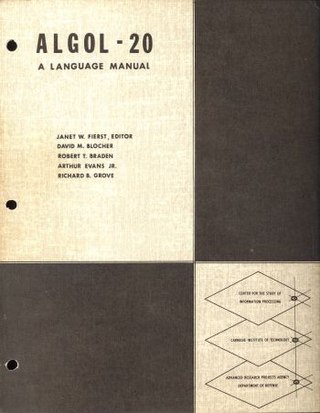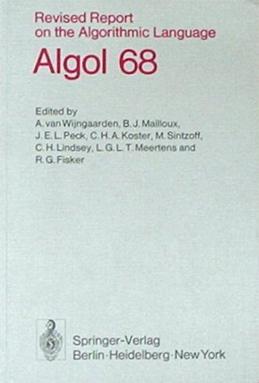| Paradigm | procedural, imperative, structured |
|---|---|
| Family | ALGOL |
| Developer | Bendix Corporation |
| First appeared | 1961 |
| Typing discipline | static, strong |
| Scope | Lexical |
| Implementation language | Assembly |
| Platform | Bendix G-15 |
| Influenced by | |
| ALGOL 58 | |
ALGO is an algebraic programming language developed for the Bendix G-15 computer. [1]
ALGO was one of several programming languages inspired by the Preliminary Report on the International Algorithmic Language written in Zürich in 1958. This report underwent several modifications before becoming the Revised Report on which most ALGOL implementations are based. As a result, ALGO and other early ALGOL-related languages have a very different syntax from ALGOL 60.
Here is the Trabb Pardo – Knuth algorithm in ALGO:
TITLE TRABB PARDO-KNUTH ALGORITHM SUBSCript I,J DATA A(11) FORMAt FI(2DT), FLARGE(3D) PROCEDURE F(T=Z) BEGIN Z=SQRT(ABS(T))+5*T^3 END FOR I=0(1)10 A[I]=KEYBD FOR J=0(1)10 BEGIN I=J-10 F(A[I]=Y) PRINT(FI)=I IF Y > 400 GO TO LARGE PRINT(FL)=Y GO TO NEXT LARGE: PRINT(FLARGE)=999 NEXT: CARR(1) END 2END 
ALGOL is a family of imperative computer programming languages originally developed in 1958. ALGOL heavily influenced many other languages and was the standard method for algorithm description used by the Association for Computing Machinery (ACM) in textbooks and academic sources for more than thirty years.
In mathematics and computing, the hexadecimal numeral system is a positional numeral system that represents numbers using a radix (base) of sixteen. Unlike the decimal system representing numbers using ten symbols, hexadecimal uses sixteen distinct symbols, most often the symbols "0"–"9" to represent values 0 to 9, and "A"–"F" to represent values from ten to fifteen.
Pascal is an imperative and procedural programming language, designed by Niklaus Wirth as a small, efficient language intended to encourage good programming practices using structured programming and data structuring. It is named after French mathematician, philosopher and physicist Blaise Pascal.

Scheme is a dialect of the Lisp family of programming languages. Scheme was created during the 1970s at the MIT AI Lab and released by its developers, Guy L. Steele and Gerald Jay Sussman, via a series of memos now known as the Lambda Papers. It was the first dialect of Lisp to choose lexical scope and the first to require implementations to perform tail-call optimization, giving stronger support for functional programming and associated techniques such as recursive algorithms. It was also one of the first programming languages to support first-class continuations. It had a significant influence on the effort that led to the development of Common Lisp.

Simula is the name of two simulation programming languages, Simula I and Simula 67, developed in the 1960s at the Norwegian Computing Center in Oslo, by Ole-Johan Dahl and Kristen Nygaard. Syntactically, it is an approximate superset of ALGOL 60, and was also influenced by the design of Simscript.
In computer science, Backus–Naur form or Backus normal form (BNF) is a metasyntax notation for context-free grammars, often used to describe the syntax of languages used in computing, such as computer programming languages, document formats, instruction sets and communication protocols. It is applied wherever exact descriptions of languages are needed: for instance, in official language specifications, in manuals, and in textbooks on programming language theory.
Plankalkül is a programming language designed for engineering purposes by Konrad Zuse between 1942 and 1945. It was the first high-level programming language to be designed for a computer.
The Knuth–Bendix completion algorithm is a semi-decision algorithm for transforming a set of equations into a confluent term rewriting system. When the algorithm succeeds, it effectively solves the word problem for the specified algebra.
ALGOL 60 is a member of the ALGOL family of computer programming languages. It followed on from ALGOL 58 which had introduced code blocks and the begin and end pairs for delimiting them, representing a key advance in the rise of structured programming. ALGOL 60 was one of the first languages implementing function definitions. ALGOL 60 function definitions could be nested within one another, with lexical scope. It gave rise to many other languages, including CPL, PL/I, Simula, BCPL, B, Pascal, and C. Practically every computer of the era had a systems programming language based on ALGOL 60 concepts.

ALGOL 68 is an imperative programming language that was conceived as a successor to the ALGOL 60 programming language, designed with the goal of a much wider scope of application and more rigorously defined syntax and semantics.
ALGOL 58, originally named IAL, is one of the family of ALGOL computer programming languages. It was an early compromise design soon superseded by ALGOL 60. According to John Backus
The Zurich ACM-GAMM Conference had two principal motives in proposing the IAL: (a) To provide a means of communicating numerical methods and other procedures between people, and (b) To provide a means of realizing a stated process on a variety of machines...
The TPK algorithm is a simple program introduced by Donald Knuth and Luis Trabb Pardo to illustrate the evolution of computer programming languages. In their 1977 work "The Early Development of Programming Languages", Trabb Pardo and Knuth introduced a small program that involved arrays, indexing, mathematical functions, subroutines, I/O, conditionals and iteration. They then wrote implementations of the algorithm in several early programming languages to show how such concepts were expressed.
In computer science, Van Wijngaarden grammars are a formalism for defining formal languages invented by Adriaan van Wijngaarden for the purpose of defining the ALGOL 68 programming language. The resulting specification remains its most notable application.
Autocode is the name of a family of "simplified coding systems", later called programming languages, devised in the 1950s and 1960s for a series of digital computers at the Universities of Manchester, Cambridge and London. Autocode was a generic term; the autocodes for different machines were not necessarily closely related as are, for example, the different versions of the single language Fortran.
ALGOL 68C is an imperative computer programming language, a dialect of ALGOL 68, that was developed by Stephen R. Bourne and Michael Guy to program the Cambridge Algebra System (CAMAL). The initial compiler was written in the Princeton Syntax Compiler that was implemented by J. H. Mathewman at Cambridge.
Jensen's device is a computer programming technique that exploits call by name. It was devised by Danish computer scientist Jørn Jensen, who worked with Peter Naur at Regnecentralen. They worked on the GIER ALGOL compiler, one of the earliest correct implementations of ALGOL 60. ALGOL 60 used call by name. During his Turing Award speech, Naur mentions his work with Jensen on GIER ALGOL.
S-algol is a computer programming language derivative of ALGOL 60 developed at the University of St Andrews in 1979 by Ron Morrison and Tony Davie. The language is a modification of ALGOL to contain orthogonal data types that Morrison created for his PhD thesis. Morrison would go on to become professor at the university and head of the department of computer science. The S-algol language was used for teaching at the university at an undergraduate level until 1999. It was also the language taught for several years in the 1980s at a local school in St. Andrews, Madras College. The computer science text Recursive Descent Compiling describes a recursive descent compiler for S-algol, implemented in S-algol.
ALGOL 68-R was the first implementation of the Algorithmic Language ALGOL 68.

In computing, a compiler is a computer program that transforms source code written in a programming language or computer language, into another computer language. The most common reason for transforming source code is to create an executable program.
DG/L is a programming language developed by Data General Corp for the Nova, Eclipse, and Eclipse/MV families of minicomputers in the 1970s and early 1980s.